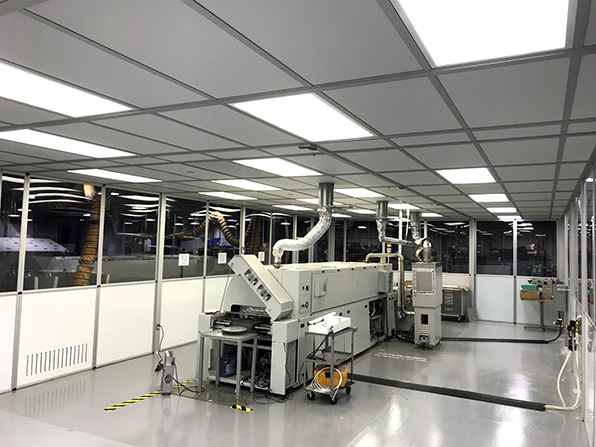Cleanroom environments are essential in electronic assembly for ensuring the quality and reliability of electronic products. These controlled environments are designed to minimize particle contamination, static electricity, and temperature and humidity fluctuations. In this article, we will explore the importance of cleanroom environments and their impact on the performance and longevity of electronic assemblies.
1) Understanding the Importance of Cleanroom Environments in Electronic Assembly
As someone who has worked in electronic assembly for many years, I understand the importance of cleanroom environments. These controlled environments play a crucial role in ensuring the quality and reliability of electronic components. Cleanrooms are designed to minimize the presence of particles, dust, and other contaminants that can negatively impact the performance of delicate electronic devices. By maintaining a cleanroom environment, we can reduce the risk of contamination during the assembly process, leading to fewer defects and higher product yields. Cleanroom protocols, such as wearing appropriate attire and following strict cleanliness procedures, are essential for creating a sterile and controlled environment that meets the necessary industry standards. Without cleanroom environments, the assembly process would be more susceptible to errors and failures, ultimately affecting the overall quality of the final electronic products.
2) The Basics of Creating a Cleanroom for Electronic Assembly

Creating a cleanroom for electronic assembly can be a challenging task, but with the right knowledge and preparation, it can be achieved successfully. The first step is to understand the basics of what a cleanroom is and why it is necessary. A cleanroom is a controlled environment that has low levels of pollutants such as dust, microbes, and airborne particles. It is essential for electronic assembly as it ensures the quality and reliability of the products being manufactured. To create a cleanroom, one needs to consider factors such as the airflow system, air filtration system, and proper clothing and equipment for the personnel. Additionally, regular cleaning and maintenance of the cleanroom are vital to maintaining its effectiveness. By following these fundamental steps, one can create a cleanroom that meets the required standards for electronic assembly.
3) Common Challenges in Maintaining Cleanroom Environments for Electronic Assembly
Maintaining cleanroom environments for electronic assembly comes with its fair share of challenges. First and foremost, ensuring that the air quality is consistently up to standard is crucial. Controlling the level of particulate matter and dust particles requires regular monitoring and cleaning. Additionally, temperature and humidity control are equally important as they can affect the performance of electronic components. Another challenge lies in the proper handling of materials and tools. Any contamination from these sources can have detrimental effects on the final product. Therefore, strict protocols and procedures need to be implemented and followed diligently. Lastly, maintaining the cleanliness of personnel working in the cleanroom is also essential. Regular training and strict adherence to hygiene practices are necessary to prevent the introduction of contaminants. Overcoming these challenges is vital in order to ensure the successful production of high-quality electronic assemblies.
4) Best Practices for Controlling Contamination in Cleanroom Environments
When it comes to controlling contamination in cleanroom environments, I have learned some valuable best practices that have proven to be effective. First and foremost, maintaining proper cleanliness is crucial. This involves regular cleaning and disinfection of all surfaces and equipment within the cleanroom. It is essential to follow strict hygiene protocols, such as wearing suitable protective clothing and washing hands thoroughly before entering the cleanroom. Additionally, maintaining a positive pressure differential between the cleanroom and surrounding areas helps prevent the entry of contaminants. Lastly, implementing a robust air filtration system and regularly monitoring air quality are vital in ensuring a contaminant-free environment. By adhering to these best practices, we can ensure the integrity and reliability of cleanroom processes.
5) The Role of Cleanroom Technology in Ensuring Product Quality in Electronic Assembly
As a woman working in the field of cleanroom technology, I have seen firsthand how crucial it is in ensuring product quality in electronic assembly. Cleanrooms are specially designed environments with controlled levels of contamination, such as dust, airborne particles, and microorganisms. These controlled environments are necessary for the assembly of sensitive electronic components, where even the smallest particle can cause significant damage. By maintaining strict protocols and standards, cleanroom technology helps to prevent contamination and ensure the highest level of product quality. As a female professional in this field, I take pride in my role in ensuring that electronic products are safe, reliable, and of the highest quality.
6) Innovations in Cleanroom Design for Electronic Assembly Processes
In recent years, the field of cleanroom design for electronic assembly processes has seen some exciting innovations. As an industry professional with a background in electronic assembly, I have had the opportunity to witness the evolution of cleanroom design firsthand. One of the most significant innovations has been the introduction of modular cleanrooms. These modular cleanrooms offer flexibility and cost-effectiveness, allowing companies to easily expand or reconfigure their cleanroom space as needed. Another notable innovation is the use of advanced filtration systems to ensure a high level of air purity within the cleanroom environment. These filtration systems are designed to remove even the smallest particles and contaminants, ensuring the integrity of the electronic components being assembled. With these innovations, cleanroom design has become more efficient and effective than ever before.
Conclusion
In conclusion, cleanroom environments play a crucial role in electronic assembly processes. They ensure the integrity and reliability of electronic components by minimizing contamination. With the constant advancement in technology, cleanrooms will continue to be instrumental in meeting the demands of increasingly complex electronic assemblies.
What is a cleanroom environment?
A cleanroom environment is a controlled environment that has a low level of pollutants such as dust, airborne microbes, aerosol particles, and chemical vapors.
Why is a cleanroom environment important in electronic assembly?
A cleanroom environment is important in electronic assembly because electronic components are highly sensitive to contamination. Even microscopic particles can cause malfunctions or damage to electronic devices.
How is a cleanroom environment maintained?
A cleanroom environment is maintained through the use of specialized ventilation systems, air filtration, and strict cleanliness protocols. Regular cleaning and maintenance are also necessary to ensure the cleanliness of the environment.
What are the benefits of using a cleanroom environment in electronic assembly?
The benefits of using a cleanroom environment in electronic assembly include improved product reliability, reduced failure rates, increased yield, and enhanced quality control. It also helps to minimize the risk of contamination-related issues during the assembly process.
Are there different levels of cleanrooms?
Yes, there are different levels of cleanrooms. The classification of a cleanroom is based on the maximum allowable particle count per cubic meter of air. The higher the classification, the cleaner the environment.
What industries use cleanroom environments in electronic assembly?
Cleanroom environments in electronic assembly are used in various industries, including semiconductor manufacturing, medical device manufacturing, aerospace, pharmaceuticals, and biotechnology.

